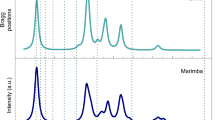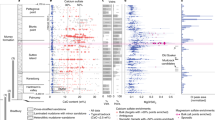Abstract
Hydrous clay minerals detected on the surface of Mars have been interpreted as indicators of the hydrologic and climatic evolution of the planet. The iron- and magnesium-rich clays described in thick, extensive outcrops of Noachian crust have been proposed to originate from aqueous weathering. This would imply that liquid water was stable at the surface of early Mars, presumably when the climate was warmer and wetter. Here we show that iron- and magnesium-rich clays can alternatively form by direct precipitation from residual, water-rich magma-derived fluids. Infrared reflectance spectra from terrestrial lavas from the Mururoa Atoll (French Polynesia) that underwent this precipitation process are similar to those measured for the Noachian crust. Such an origin is also consistent with the D/H ratio of iron- and magnesium-rich clays in some martian meteorites and the widespread presence of these clays in massive basaltic lavas, breccias and regolith. We propose that the progressive degassing of the martian interior over time and the resultant increasingly water-poor magmatic fluids—and not a cooling climate—may explain the absence of clays in Hesperian-aged and more recent formations.
This is a preview of subscription content, access via your institution
Access options
Subscribe to this journal
Receive 12 print issues and online access
$259.00 per year
only $21.58 per issue
Buy this article
- Purchase on Springer Link
- Instant access to full article PDF
Prices may be subject to local taxes which are calculated during checkout



Similar content being viewed by others
References
Poulet, F. et al. The Omega Team Phyllosilicates on Mars and implications for early martian climate. Nature 438, 623–627 (2005).
Bishop, J. L., Lane, M. D., Dyar, M. D. & Brown, A. J. Reflectance and emission spectroscopy study of four groups of phyllosilicates: Smectites, kaolinite-serpentines, chlorites and micas. Clay Miner. 43, 35–54 (2008).
Clark, R. N., King, T. V. V., Klejwa, M., Swayze, G. A. & Vergo, N. High spectral resolution reflectance spectroscopy of minerals. J. Geophys. Res. 95, 12653–12680 (1990).
Mustard, J. F. et al. Hydrated silicate minerals on Mars observed by the Mars Reconnaissance Orbiter CRISM instrument. Nature 454, 305–309 (2008).
Ehlmann, B. L. et al. Subsurface water and clay mineral formation during the early history of Mars. Nature 479, 53–60 (2011).
Carter, J., Poulet, F., Bibring, J. P. & Murchie, S. Detection of hydrated silicates in crustal out crops in the Northern Plains of Mars. Science 328, 1682–1686 (2010).
Mangold, N. et al. Mineralogy of the Nili Fossae region with OMEGA/Mars Express data: 2. Aqueous alteration of the crust. J. Geophys. Res. 112, E08S04 (2007).
Bish, D. L., Carey, J. W., Vaniman, D. T. & Chipera, S. Stability of hydrous minerals on the martian surface. Icarus 164, 96–103 (2003).
Ehlmann, B. L. et al. Identification of hydrated silicate minerals on Mars using MRO-CRISM: Geologic context near Nili Fossae and implications for aqueous alteration. J. Geophys. Res. 114, E00D08 (2009).
Loizeau, N. et al. Stratigraphy in the Mawrth Vallis region through OMEGA, HRSC color imagery and DTM. Icarus 205, 396–418 (2010).
Amundson, R. et al. On the in situ aqueous alteration of soils on Mars. Geochim. Cosmochim. Acta 72, 3845–3864 (2008).
Pollack, J. B., Kasting, J. F., Richardson, S. M. & Poliakoff, K. The case for a wet, warm climate on early Mars. Icarus 71, 203–224 (1987).
Chevrier, V., Poulet, F. & Bibring, J. P. Early geochemical environment of Mars as determined from thermodynamics of phyllosilicates. Nature 448, 60–63 (2007).
Michalski, J. R. & Noe Dobrea, E. Z. Evidence for a sedimentary origin of clay minerals in the Mawrth Vallis region. Mar. Geol. 35, 951–954 (2007).
Wray, J. J., Ehlmann, B. L., Squyres, S. W., Mustard, J. F. & Kirk, R. L. Compositional stratigraphy of clay-bearing layered deposits at Mawrth Vallis, Mars. Geophys. Res. Lett. 35, L12202 (2008).
White, A. F. & Brantley, S. L. The effects of time on the weathering of silicate minerals: Why do weathering rates differ in the laboratory and field? Chem. Geol. 202, 479–506 (2003).
Milliken, R. E., Fischer, W. W. & Hurowitz, J. A. Missing salts on early Mars. Geophys. Res. Lett. 36, L11202 (2009).
Treiman, A. H. The nakhlite meteorites: Augite-rich igneous rocks from Mars. Chem. Erde Geochem. 65, 203–270 (2005).
Swindle, T. G. & Olson, E. K. 40Ar–39Ar studies of whole rock nakhlites: Evidence for the timing of formation and aqueous alteration on Mars. Meteorit. Planet. Sci. 39, 755–766 (2004).
Changela, H. G. & Bridges, J. C. Alteration assemblages in the nakhlites: Variation with depth on Mars. Meteorit. Planet. Sci. 45, 1847–1867 (2010).
Leshin, L. A. & Vicenzi, E. Aqueous processes recorded by Martian meteorites: Analyzing Martian water on Earth. Elements 2, 157–162 (2006).
Gillet, P. et al. Aqueous alteration in the Northwest Africa 817 (NWA 817) Martian meteorite. Earth Planet. Sci. Lett. 203, 431–444 (2002).
Lentz, R. C. F., McSween, H. Y. Jr, Ryan, J. & Riciputt, L. R. Water in martian magmas: Clues from light lithophile elements in shergottite and nakhlite pyroxenes. Geochim. Cosmochim. Acta 65, 4551–4565 (2001).
Herd, C. D. K., Treiman, A. H., McKay, G. A. & Shearer, C. K. Light lithophile elements in martian basalts: Evaluating the evidence for magmatic water degassing. Geochim. Cosmochim. Acta 69, 2431–2440 (2005).
Treiman, A. H., Musselwhite, D. S., Herd, C. D. K. & Shearer, C. K. Light lithophile elements in pyroxenes of Northwest Africa (NWA) 817 and other Martian meteorites: Implications for water in Martian magmas. Geochim. Cosmochim. Acta 70, 2919–2934 (2006).
Filiberto, J. & Treiman, A. H. Martian magmas contained abundant chlorine, but little water. Geology 12, 1087–1090 (2009).
McCubbin, F. M. & Nekvasil, H. Maskelynite-hosted apatite in the Chassigny meteorite: Insights into late stage magmatic volatile evolution in martian magmas. Am. Mineral. 93, 676–684 (2008).
Meunier, A., Mas, A., Beaufort, D., Patrier, P. & Dudoignon, P. Clay minerals in basalt-hawaiite rocks from Mururoa atoll (French Polynesia). II. Petrography and geochemistry. Clays Clay Miner. 56, 730–750 (2008).
Drief, A. & Schiffman, P. Very low temperature alteration of sideromelane in hyaloclastites and hyalotuffs from Kilauea and Mauna Kea volcanoes: Implications for the mechanism of palagonite formation. Clays Clay Miner. 52, 622–634 (2004).
Destrigneville, C., Schott, J., Caristan, Y. & Agrinier, P. Evidence of an early alteration process driven by magmatic fluid in Mururoa volcano. Earth Planet. Sci. Lett. 104, 119–139 (1991).
Schenato, F., Formoso, M. L. L., Dudoignon, P., Meunier, A., Proust, D. & Mas, A. Alteration processes of the thick basaltic lava flow of the Parana Basin (Brazil): Petrographic and mineralogical studies. J. South Am. Earth Sci. 16, 423–444 (2003).
Berger, G. & Meunier, A. The out-gassing of basalt flows as a source of Martian phyllosilicates. in XIV Int. Clay Conf. Vol. 1 314 (2009).
McEwen, A. S., Malin, M. C., Carr, M. H. & Hartmann, W. K. Voluminous volcanism on early Mars revealed in Valles Marineris. Nature 397, 584–586 (1999).
Lorand, J. P., Chevrier, V. & Sautter, V. Sulfide mineralogy and redox conditions in some shergottites. Meteorit. Planet. Sci. 40, 1257–1272 (2005).
Shinohara, H. A missing link between volcanic degassing and experimental studies on chloride partitioning. Chem. Geol. 263, 51–59 (2009).
Berger, G., Toplis, M. J., Treguier, E., d’Uston, C. & Pinet, P. Evidence in favour of small amounts of ephemeral and transient water during alteration at Meridiani Planum, Mars. Am. Mineral. 94, 1279–1282 (2009).
Filiberto, J. & Treiman, A. H. The effect of chlorine on the liquidus of basalt: First results and implications for basalt genesis on Mars and Earth. Chem. Geol. 263, 60–68 (2009).
Decarreau, A., Petit, S., Vieillard, P. & Dabert, N. Hydrothermal synthesis of aegirine at 200° C. Eur. J. Miner. 16, 85–90 (2004).
Acknowledgements
This study was supported by the University of Poitiers, the French CNRS-INSU and by a French ANR ‘Jeunes Chercheurs’ programme (contract no. ANR-09-JCJC-0,106-PorousClay). We are grateful to V. F. Chevrier and B. Hynek for their comments and suggestions that have improved our manuscript. We thank S. Riffault for her contribution to the drawing of Fig. 3.
Author information
Authors and Affiliations
Contributions
A.Meunier conceived and headed the project. B.L.E. and F.W. contributed to the description of martian geology features and the interpretation of the petrographical characteristics of martian meteorites. The petrographical study of terrestrial basalts was performed by A.Mas and P.D. Infrared spectra were acquired and interpreted by S.P. Finally, B.L.E., F.W., A.E.A. and E.F. provided critical input to the manuscript.
Corresponding author
Ethics declarations
Competing interests
The authors declare no competing financial interests.
Supplementary information
Supplementary Information
Supplementary Information (PDF 932 kb)
Rights and permissions
About this article
Cite this article
Meunier, A., Petit, S., Ehlmann, B. et al. Magmatic precipitation as a possible origin of Noachian clays on Mars. Nature Geosci 5, 739–743 (2012). https://doi.org/10.1038/ngeo1572
Received:
Accepted:
Published:
Issue Date:
DOI: https://doi.org/10.1038/ngeo1572
This article is cited by
-
Primordial clays on Mars formed beneath a steam or supercritical atmosphere
Nature (2017)
-
Indicators and Methods to Understand Past Environments from ExoMars Rover Drills
Origins of Life and Evolution of Biospheres (2016)
-
Uninhabitable martian clays?
Nature Geoscience (2012)



